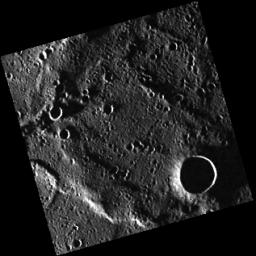
|
Groundhog Day
- Click the image above for a larger view
- Full-Res JPEG (317 x 317) (20.8 kB)
- Full-Res TIFF (317 x 317) (100.8 kB)
Caption:
This image features a simple crater surrounded by a relatively smooth surface. The pristine crater rim is an indication that this is a relatively fresh crater. The high incidence angle at which this image was taken results in a large shadow covering the crater floor, making it appear very deep -- the perfect depth for a future groundhog spotting.
Date acquired:
April 15, 2011
Image Mission Elapsed Time (MET):
211373761
Image ID:
134995
Instrument:
Wide Angle Camera (WAC) of the Mercury Dual Imaging System (MDIS)
WAC filter:
7 (748 nanometers)
Center Latitude:
82.30°
Center Longitude:
29.57° E
Resolution:
324 meters/pixel
Scale:
The crater is about 15 km (9 miles) in diameter.
Incidence Angle:
87.9°
Emission Angle:
0.1°
Phase Angle:
87.8°
Background Info:
The MESSENGER spacecraft is the first ever to orbit the planet Mercury, and the spacecraft's seven scientific instruments and radio science investigation are unraveling the history and evolution of the Solar System's innermost planet. Visit the Why Mercury? section of this website to learn more about the key science questions that the MESSENGER mission is addressing. During the one-year primary mission, MDIS acquired 88,746 images and extensive other data sets. MESSENGER is now in a year-long extended mission, during which plans call for the acquisition of more than 80,000 additional images to support MESSENGER's science goals.
These images are from MESSENGER, a NASA Discovery mission to conduct the first orbital study of the innermost planet, Mercury. For information regarding the use of images, see the MESSENGER image use policy .
Cataloging Keywords:
| Name | Value | Additional Values |
|---|---|---|
| Target | Mercury | |
| System | ||
| Target Type | Planet | |
| Mission | MESSENGER | |
| Instrument Host | MESSENGER | |
| Host Type | Orbiter | |
| Instrument | Mercury Dual Imaging System (MDIS) | |
| Detector | Wide Angle Camera (WAC) | |
| Extra Keywords | Crater, Grayscale, Radio, Shadow | |
| Acquisition Date | ||
| Release Date | 2012-07-06 | |
| Date in Caption | 2011-04-15 | |
| Image Credit | NASA/Johns Hopkins University Applied Physics Laboratory/Carnegie Institution of Washington | |
| Source | photojournal.jpl.nasa.gov/catalog/PIA16353 | |
| Identifier | PIA16353 | |
